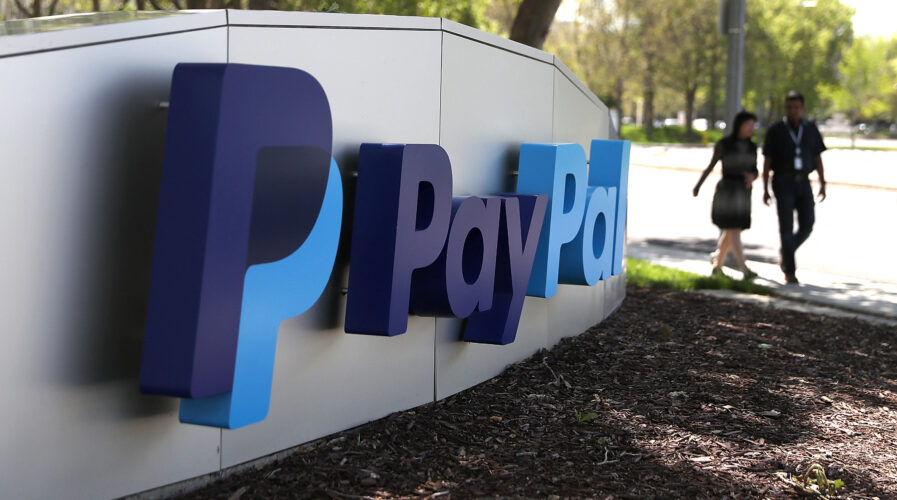
(Photo by JUSTIN SULLIVAN / GETTY IMAGES NORTH AMERICA / Getty Images via AFP)
PayPal wants to help SMEs future proof their digital business
PayPal has been enabling business payments around the world for years. Despite the rise of new payment methods, PayPal feels they still have an important role to play in helping businesses achieve the best outcomes.
In Asia, the final quarter of the year is often filled with shopping festivals. Despite the pandemic disrupting retail sales in shopping malls, e-Commerce sales continue to see tremendous success due to the change in consumer behaviors.
Yearend shopping festivals like 11.11, Singles Day, Black Friday, Christmas, Boxing Day, and such not only bring more sales but also increase the risks of cybercrime among some businesses. While e-Commerce platforms have been benefiting from these, SMEs account for 96% of all businesses in Asia and need to future proof their digitized businesses.
In fact, the Cyber Security Agency of Singapore reported that ransomware cases spiked by 154% in Singapore alone last year, affecting mostly SMEs in sectors like retail and healthcare. Another report flagged that Asia’s users are 1.7 times more likely to encounter ransomware than in the rest of the world.
At the same time, consumer preference in payment methods and the user experience in platforms from start to checkout has also evolved. Customers want a seamless experience when shopping online and SMEs need to do their best in delivering that.
To understand more about how SMEs can not only secure their business but also their customers as well deliver what customers really want, Tech Wire Asia spoke to Jim Magats, Senior Vice President for Omni Payments at PayPal to get his insights on the industry.
There is a myriad of tech companies offering a variety of solutions for SMEs to build a sustainable digital e-Commerce business. How do SMEs make the right choice, especially when it comes to securing payments?
One of the biggest decisions to make when setting up an online business is selecting the right platform to build and manage your website and online store. To start, look for an open and interoperable e-Commerce platform that fits your particular business and enables you to easily connect with other platforms you may need to help with everything from payments to shipping to inventory and order management. As we move toward a multichannel or omnichannel world, it’s also critical to make sure you work with a partner that can help connect your in-person and online stores from a backend perspective, so things like cataloging, payments, and inventory and order management are seamlessly integrated so your customers have a consistent experience across channels.
In addition, it’s important to think about the payments piece. Work with a partner that enables you to offer your customers choice in terms of payment methods, so your customers can pay with traditional cards but also digital wallets, buy now pay later solutions, rewards points, and more. Finally, as online commerce is increasing, so too is online fraud. It’s important to work with a partner that can help you effectively combat and manage fraud.
Studies have shown that a bad customer experience will lead to customers moving away from the brand. How much attention should SMEs give to improving the customer experience? Which aspects of it should the focus mostly on?
Customer experience truly is a differentiator. Customers are looking for fast, seamless, secure, and delightful experiences, and they have a lot of brands to choose from. If a customer has a bad experience on a site, there’s a strong chance they won’t go back to that site again. With more than two billion digital global buyers, according to eMarketer, the reach has never been higher. Research has found that 80% of shoppers stop transacting on sites with a poor experience, and 47% of customers trust a seller with a good payments process.
Optimizing how and where payment options are presented throughout the shopping journey, not just at checkout, is critical. Busy, distracted consumers demand frictionless checkout. Despite the rise in e-Commerce, the average e-Commerce conversion rate across the industry is around 3%.
A good payments experience helps remove barriers that lead to reconsideration. It also lets customers stay excited about what they’re purchasing, instead of overthinking the payment and checkout piece and potentially abandoning their cart.
One thing businesses should consider when thinking about the customer experience is the full end-to-end customer journey—identifying points of a drop-off in the sales funnel, enabling cart abandonment retargeting so customers can easily pick back up where they left off and enabling customer choice when it comes to payment options.
Enabling a range of seamless and secure payment options – like PayPal for example – can help consumers convert. According to a comScore study, PayPal Checkout converts at 88.7%, which is 82% higher than checkouts that use other payments. So, the payment piece is a critical part of the customer experience.
While securing digital payments are key, customers have a variety of payment options to choose from today. What pitfalls should businesses avoid when managing their payments?
The way people pay has changed during the pandemic and we see a definitive shift towards digital payments. Consumers are also using smartphones and other wearable tech to make these payments. Understanding your customers’ behaviors and expectations is key to deciding the kind of e-Commerce and payments platform you choose Consumers could be abandoning their carts because they are expected to key in too much information, or it takes too long to process the payment, or their preferred payment option isn’t available.
Pick a platform that is customer-friendly, convenient, and secure. Finally, it’s important to offer your customers a choice. Don’t offer your customers just one form of payment. Consumers want to be able to choose from a range of payment options, from cards to digital wallets to buy now pay later solutions and even rewards points.
How is PayPal helping SMEs scale up their businesses, transact securely and protect their data?

(Photo by JUSTIN SULLIVAN / GETTY IMAGES NORTH AMERICA / Getty Images via AFP)
Whether you’re selling online, in-person, or some combination of the two, PayPal delivers a complete and secure payments and commerce solution with the global scale and flexibility a business needs to stay competitive.
PayPal’s Commerce Platform helps businesses increase their local and international sales by providing flexible solutions that help businesses accept payments in over 100 currencies. We also help safeguard these transactions with 24/7 fraud monitoring, while Buyer and Seller Protection helps protect eligible transactions against chargebacks, reversals due to fraud, and claims that items were not received.
To ensure transactions are secure, PayPal tokenizes payment credentials and employs two-step authentication, which sends businesses a one-time personal identification number (PIN), which is unique for each login session.
End-to-end encryption is key to keeping data and PayPal business transactions secure. Our team of security and compliance experts is dedicated to educating customers on industry standards and supporting them in securing their critical assets.
As a two-sided platform, we can help businesses grow by connecting them with our more than 400 million global active accounts and helping them sell across borders and across channels – from social media to marketplaces to in-store, online, or in mobile apps. We also have solutions for every stage of a company’s growth – from casual sellers to SMEs to large enterprises.
How is the PayPal business dealing with the competition in payments today? With the rise of digital banking and e-wallets, where does PayPal see itself in the industry in the future?
Since its founding more than 20 years ago, the PayPal business has been the leader in digital payments. Over the past several years, we’ve moved beyond our existing offerings to offer more financial services solutions for our consumers and more commerce solutions for our businesses. We processed $936 billion in total payment volume (TPV) in 2020 and are on track to reach US$ 1 trillion a year.
Digital payment usage surged during the pandemic and will only continue to increase. We expect the annual volume of payments we handle to triple by 2025, rising to US$ 2.8 trillion from US$ 936 billion in 2020.
To meet our customer’s evolving demands for safe and secure digital payments over the past two years, we launched new products like QR Codes for safe in-person payments, our buy now pays later solutions Pay in 4 and Pay in 3, and our buy hold and sell cryptocurrency service. We also recently launched PayPal Zettle – our in-store POS and omnichannel solution for small businesses in the U.S.
Our latest development is the new PayPal App, which is laying the groundwork for other new products in the quarters to come. It currently offers a combination of financial tools including direct deposit, bill pay, peer-to-peer payments, shopping tools, crypto capabilities, and more. PayPal business customers will be able to browse the discounts and offers inside the app, then shop and transact through the in-app browser. And this is just the beginning.
Lastly, how different are SMEs’ adoption to e-Commerce and payment security in the region? Are Singaporean SMEs better prepared compared to other SMEs in Southeast Asia?
An ASME-Microsoft study has found that 83% of SMEs in Singapore now have digital transformation strategies in place, and these businesses have also transformed at a more rapid pace than what has been seen across other markets during the pandemic. Digitization has also led to an increase in cloud adoption, a 30% increase from 2019. Adoption has also been supported by the initiatives by the government to help SMBs shift to digital.
We have also seen significant growth in cross-border selling by Singapore businesses. According to PayPal’s Borderless Commerce Report 2021, amid its greatest-ever recession, cross-border shopping remains a defining feature of Singapore’s e-Commerce market. 78% of Singaporeans shop cross-border—the highest in the region (i.e. compared to 73% in Hong Kong, 49% in India, 39% in China, and 21% in Japan). Almost 80% of online consumers purchase from international websites, largely driven by lower prices (56%), greater access to products not available in the local market (45%), and discovery of new and interesting products while browsing online (37%).
READ MORE
- Strategies for Democratizing GenAI
- The criticality of endpoint management in cybersecurity and operations
- Ethical AI: The renewed importance of safeguarding data and customer privacy in Generative AI applications
- How Japan balances AI-driven opportunities with cybersecurity needs
- Deploying SASE: Benchmarking your approach
